Indian Railways
 | |
| Company type | Government-owned corporation |
|---|---|
| Industry | Railways |
| Founded | 16 April 1853[1] |
| Headquarters | New Delhi, India |
Area served | India |
Key people | Mukul Roy Minister of Railways Vinay Mittal (Chairman)[2] |
| Services | Passenger railways freight services bus transportation travel agency services parking lot operations other related services |
| Revenue | |
| Owner | Government of India (100%) |
Number of employees | 1.4 million (2011)[4] |
| Divisions | 16 Railway Zones |
| Website | www |
| Overview | |
|---|---|
| Headquarters | New Delhi, India |
| Reporting mark | IR |
| Locale | India |
| Dates of operation | 16 April 1853–Present |
| Technical | |
| Track gauge | 1676 mm; 1000 mm; 762 mm; 610 mm |
| Electrification | 21,500 km |
| Length | 65,000 km |
| Other | |
| Website | www |
Indian Railways (reporting mark IR) is an Indian state-owned enterprise, owned and operated by the government of India through the Ministry of Railways. It is one of the world's largest railway networks comprising 115,000 km (71,000 mi) of track over a route of 65,000 km (40,000 mi) and 7,500 stations. IR carries about 7,500 million passengers annually or more than 20 million passengers daily (more than a half of which are suburban passengers) and 2.8 million tons of freight daily. In 2011-2012 Indian Railways earned ₹104,278.79 crore (US$12 billion) which consists of ₹69,675.97 crore (US$8.3 billion) from freight and ₹28,645.52 crore (US$3.4 billion) from passengers tickets.
Railways were first introduced to India in 1853 from Bombay to Thane. In 1951 the systems were nationalized as one unit, the Indian Railways, becoming one of the largest networks in the world. IR operates both long distance and suburban rail systems on a multi-gauge network of broad, metre and narrow gauges. It also owns locomotive and coach production facilities at several places in India and are assigned codes identifying their gauge, kind of power and type of operation. Its operations cover twenty four states and three union territories and also provides limited international services to Nepal, Bangladesh and Pakistan.
Indian Railways is the world's fourth largest commercial or utility employer, by number of employees, with over 1.4 million employees. As for rolling stock, IR holds over 229,381 Freight Wagons, 59,713 Passenger Coaches and 9,213 Locomotives. The trains have a 5 digit numbering system as the Indian Railways runs about 10,000 trains daily. As of 31 March 2012, 22,224 km (13,809 mi) (34%) of the total 65,000 km (40,000 mi) km route length was electrified.[5]. Since 1960, almost all electrified sections on IR use 25,000 Volt AC traction through overhead catenary delivery.
History

The history of rail transport in India began in the mid-nineteenth century. In 1849, there was not a single kilometre of railway line in India. A British engineer, Robert Maitland Brereton, was responsible for the expansion of the railways from 1857 onwards. The Allahabad-Jubbulpore branch line of the East Indian Railway had been opened in June 1867. Brereton was responsible for linking this with the Great Indian Peninsula Railway, resulting in a combined network of 6,400 km (4,000 mi). Hence it became possible to travel directly from Bombay to Calcutta. This route was officially opened on 7 March 1870 and it was part of the inspiration for French writer Jules Verne's book Around the World in Eighty Days. At the opening ceremony, the Viceroy Lord Mayo concluded that “it was thought desirable that, if possible, at the earliest possible moment, the whole country should be covered with a network of lines in a uniform system”. [6]
By 1875, about £95 million were invested by British companies in Indian guaranteed railways.[7] By 1880 the network had a route mileage of about 14,500 km (9,000 mi), mostly radiating inward from the three major port cities of Bombay, Madras and Calcutta. By 1895, India had started building its own locomotives, and in 1896 sent engineers and locomotives to help build the Uganda Railways.
In 1900, the GIPR became a government owned company. The network spread to the modern day states of Assam, Rajasthan and Andhra Pradesh and soon various independent kingdoms began to have their own rail systems. In 1905, an early Railway Board was constituted, but the powers were formally invested under Lord Curzon.[8] It served under the Department of Commerce and Industry and had a government railway official serving as chairman, and a railway manager from England and an agent of one of the company railways as the other two members. For the first time in its history, the Railways began to make a profit.
In 1907 almost all the rail companies were taken over by the government. The following year, the first electric locomotive made its appearance. With the arrival of World War I, the railways were used to meet the needs of the British outside India. With the end of the war, the railways were in a state of disrepair and collapse.
In 1920, with the network having expanded to 61,220 km, a need for central management was mooted by Sir William Acworth. Based on the East India Railway Committee chaired by Acworth, the government took over the management of the Railways and detached the finances of the Railways from other governmental revenues.
The period between 1920 and 1929 was a period of economic boom; there were 41,000 miles of railway lines serving the country; the railways represented a capital value of some 687 million sterling; and they carried over 620 million passengers and approximately 90 million tons of goods each year.[9] Following the Great Depression, the railways suffered economically for the next eight years. The Second World War severely crippled the railways. Starting 1939, about 40% of the rolling stock including locomotives and coaches was taken to the Middle East, the railways workshops were converted to ammunitions workshops and many railway tracks were dismantled to help the British in their war. By 1946 all rail systems had been taken over by the government.
Organisational structure
Railway zones
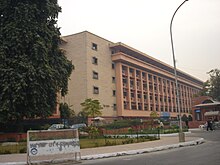
Indian Railways is divided into several zones, which are further sub-divided into divisions. The number of zones in Indian Railways increased from six to eight in 1951, nine in 1952 and sixteen in 2003.[10][11] Each zonal railway is made up of a certain number of divisions, each having a divisional headquarters. There are a total of sixty-eight divisions.[4][12]
Each of the sixteen zones is headed by a General Manager (GM) who reports directly to the Railway Board. The zones are further divided into divisions under the control of Divisional Railway Managers (DRM). The divisional officers of engineering, mechanical, electrical, signal and telecommunication, accounts, personnel, operating, commercial and safety branches report to the respective Divisional Manager and are in charge of operation and maintenance of assets. Further down the hierarchy tree are the Station Masters who control individual stations and the train movement through the track territory under their stations' administration.


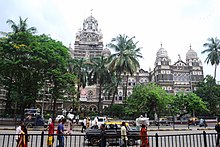
Recruitment and training
Staff are classified into gazetted (Group 'A' and 'B') and non-gazetted (Group 'C' and 'D') employees.[13] The recruitment of Group 'A' gazetted employees is carried out by the Union Public Service Commission through exams conducted by it.[14] The recruitment to Group 'C' and 'D' employees on the Indian Railways is done through 20 Railway Recruitment Boards which are controlled by the Railway Recruitment Control Board (RRCB).[15] The training of all cadres is entrusted and shared between six centralized training institutes.
Production units
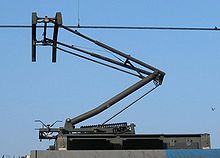

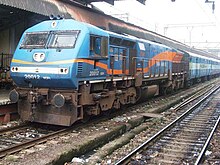
Indian Railways manufactures much of its rolling stock and heavy engineering components at its six manufacturing plants, called Production Units, which are managed directly by the Ministry. Popular rolling stock builders such as CLW and DLW for electric and diesel locomotives; ICF and RCF for passenger coaches are Production Units of Indian Railways. Over the years, Indian Railways has not only achieved self-sufficiency in production of rolling stock in the country but also exported rolling stock to other countries. Each of these six production units is headed by a General Manager, who also reports directly to the Railway Board. The six Production Units are:-
| Sl. No | Name | Abbr. | Year Established | Location | Main products |
|---|---|---|---|---|---|
| 1. | Golden Rock Locomotive Workshops | GOC | 1928 | Trichy | Diesel-electric Locomotives |
| 2. | Chittaranjan Locomotive Works | CLW | 1947 | Chittaranjan, Asansol | Electric Locomotives |
| 3. | Diesel Locomotive Works | DLW | 1961 | Varanasi | Diesel Locomotives |
| 4. | Diesel-Loco Modernisation Works | DMW | 1981 | Patiala | Diesel-electric Locomotives |
| 5. | Integral Coach Factory | ICF | 1952 | Chennai | Passenger coaches |
| 6. | Rail Coach Factory | RCF | 1986 | Kapurthala | Passenger coaches |
| 7. | Rail Wheel Factory | RWF | 1984 | Bangalore | Railway wheels and axles |
| 8. | Rail Wheel Factory | RWF | 2011 | Chhapra | Railway wheels and axles |
Other subsidiaries
There also exist independent organizations under the control of the Railway Board for electrification, modernization, research and design and training of officers, each of which is headed by an officer of the rank of General Manager. A number of Public Sector Undertakings, which perform railway-related functions ranging from consultancy to ticketing, are also under the administrative control of the Ministry of railways.
There are eleven public undertakings under the administrative control of the Ministry of Railways,[16] viz.
- Bharat Wagon and Engineering Co. Ltd. (BWEL)
- Centre for Railway Information Systems (CRIS)[17]
- Container Corporation of India Limited (CONCOR)
- Dedicated Freight Corridor Corporation of India Limited (DFCCIL)
- Indian Railway Catering and Tourism Corporation Limited (IRCTC)
- Indian Railway Construction (IRCON) International Limited
- Indian Railway Finance Corporation Limited (IRFC)
- Konkan Railway Corporation Limited (KRCL)
- Mumbai Railway Vikas Corporation (MRVC)
- Railtel Corporation of India Limited (Rail Tel)
- Rail India Technical and Economic Services Limited (RITES)
- Rail Vikas Nigam Limited (RVNL)
Delhi Metro Rail Corporation Limited (DMRC), that has constructed and operates Delhi Metro network, is an independent organisation not connected to the Indian Railways. Similar metro rail corporations in other ciities (except Calcutta) are not connected to the Indian Railways.
Locomotives


Locomotives in India consist of electric and diesel locomotives. Steam locomotives are no longer used, except in heritage trains. Locomotives are also called locos or engines. In India, locomotives are classified according to their track gauge, motive power, the work they are suited for and their power or model number. The class name includes this information about the locomotive. It comprises 4 or 5 letters. The first letter denotes the track gauge. The second letter denotes their motive power (Diesel or Electric) and the third letter denotes the kind of traffic for which they are suited (goods, passenger, mixed or shunting). The fourth letter used to denote locomotives' chronological model number. However, from 2002 a new classification scheme has been adopted. Under this system, for newer diesel locomotives, the fourth letter will denote their horsepower range. Electric locomotives don't come under this scheme and even all diesel locos are not covered. For them this letter denotes their model number as usual.
A locomotive may sometimes have a fifth letter in its name which generally denotes a technical variant or subclass or subtype. This fifth letter indicates some smaller variation in the basic model or series, perhaps different motors, or a different manufacturer. With the new scheme for classifying diesel locomotives (as mentioned above) the fifth item is a letter that further refines the horsepower indication in 100 hp increments: 'A' for 100 hp, 'B' for 200 hp, 'C' for 300 hp, etc. So in this scheme, a WDM-3A refers to a 3100 hp loco, while a WDM-3F would be a 3600 hp loco.
Note: This classification system does not apply to steam locomotives in India as they have become non-functional now. They retained their original class names such as M class or WP class.
As of 31 March 2010, Indian Railways had 5,022 diesel locomotives (increased from 17 on 31 March 1951), 3,825 electric locomotives (increased from 72 on 31 March 1951) and 42 steam locomotives (decreased from 8,120 on 31 March 1951) (see Railway Budget 2012-13 Explantory Memorandum).
Goods wagons or freight cars
The number of freight car or goods wagons was 205,596 on 31 March 1951 and reached the maximum number 405,183 on 31 March 1980 after which it started declining and was 219,931 on 31 March 2010. The number is far shorter than the requirement and the Indian Railways keeps losing freight traffic to road. Indian Railways carried 93 million tonnes of goods in 1950-51 and it increased to 892 tonnes in 2009-10.
However, its share in goods traffic is much lower than road traffic. In 1951, its share was 65% and the share of road was 35%. Now the shares have been reversed and the share of railways has declined to 30% and the share of road has increased to 70%.
Passenger coaches
Indian railways has several types of passenger coaches.
Electric Multiple Unit (EMU) coaches are used for suburban traffic in large cities - mainly Mumbai, Chennai, Delhi, Kolkata, Pune, Hyderabad and Bangalore. These coaches numbered 7,474 on 31 March 2010. They have second class and first class seating accommodation.
Passenger coaches numbered 43,518 on 31 March 2010. Other coaches (luggage coach, parcel van, guard's coach, mail coach, etc.) numbered 6,505 on 31 March 2010.
Freight
Indian Railways earns about 70% of its revenues from the freight traffoc (Rs.686.2 billion from freight and Rs.304.6 billion from passengers in 2011-12). Most of its profits come from movement of freight. It makes a loss on passenger traffic. It deliberately keeps its passenger fares low and cross-subsidises the loss-making passenger traffic with the profit-making freight traffic.
Since the 1990s, Indian Railways has stopped single-wagon consignments and provides only full rake freight trains for goods. Most of its freight earnings come from movement of bulk goods such as coal, cement, food grains and iron ore in full rakes. It is continually losing freight traffic to road.
Technical details
Track and gauge
Indian railways uses four gauges, the 1,676 mm (5 ft 6 in) broad gauge which is wider than the 1,435 mm (4 ft 8+1⁄2 in) standard gauge; the 1,000 mm (3 ft 3+3⁄8 in) metre gauge; and two narrow gauges, 762 and 610. Track sections are rated for speeds ranging from 75 to 160 km/h (47 to 99 mph).
The total length of track used by Indian Railways is about 115,000 km (71,000 mi) while the total route length of the network is 65,000 km (40,000 mi).[18] About 22,224 km (13,809 mi) or 34% of the route-kilometre was electrified as on 31 March 2012.[19]

Broad gauge is the predominant gauge used by Indian Railways. Indian broad gauge—1676—is the most widely used gauge in India with 105,000 km (65,000 mi) of track length (91% of entire track length of all the gauges) and 56,000 km (35,000 mi) of route-kilometre (86% of entire route-kilometre of all the gauges).
In some regions with less traffic, the metre gauge (1,000 mm / 3 ft 3+3⁄8 in) is common, although the Unigauge project is in progress to convert all tracks to broad gauge. The metre gauge has about 8,000 km (5,000 mi) of track length (7% of entire track length of all the gauges) and 7,000 km (4,300 mi) of route-kilometre (10% of entire route-kilometre of all the gauges).
The Narrow gauges are present on a few routes, lying in hilly terrains and in some erstwhile private railways (on cost considerations), which are usually difficult to convert to broad gauge. Narrow gauges have 2,000 route-kilometre. The Kalka-Shimla Railway, the Kangra Valley Railway and the Darjeeling Himalayan Railway are three notable hill lines that use narrow gauge, but the Nilgiri Mountain Railway is a metre gauge track.[20] These four rail lines will not be converted under the Unigauge project.
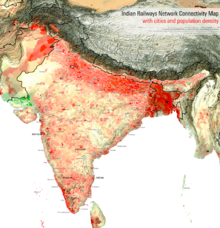
The share of broad gauge in the total route-kilometre has been steadily rising, increasing from 47% (25,258 route-km) in 1951 to 86% in 2012 whereas the share of metre gauge has declined from 45% (24,185 route-km) to 10% in the same period and the share of narrow gauges has decreased from 8% to 3%. However, the total route-kilometre has increased by only 21% (by just 11,500 km from 53,596 route-km in 1951) in the last sixty years or about 200 km per year. This compares very poorly with Chinese railways, which increased from about 27,000 route-km at the end of second world war to about 100,000 route-km in 2011, an increase of more than threefold. More than 28,000 route-km (34% of the total route-km) of Chinese railway is electrified compared to only about 21,500 route-km of Indian railways.
Sleepers (ties) are made up of prestressed concrete, or steel or cast iron posts, though teak sleepers are still in use on a few older lines. The prestressed concrete sleeper is in wide use today. Metal sleepers were extensively used before the advent of concrete sleepers. Indian Railways divides the country into four zones on the basis of the range of track temperature. The greatest temperature variations occur in Rajasthan.
Railway links to adjacent countries
Existing rail links:
 Nepal – Break-of-gauge – Gauge conversion under uni-gauge project
Nepal – Break-of-gauge – Gauge conversion under uni-gauge project Pakistan – same Broad Gauge. Thar Express to Karachi and the more famous Samjhauta Express international train from Lahore, Pakistan to Amritsar (Attari).
Pakistan – same Broad Gauge. Thar Express to Karachi and the more famous Samjhauta Express international train from Lahore, Pakistan to Amritsar (Attari). Bangladesh – Same Broad Gauge. The Maitri Express between Dhaka and Kolkata started in April 2008 using the Gede-Darsana route, in addition to a Freight Train service from Singhabad and Petrapole in India to Rohanpur and Benapole in Bangladesh A second passenger link between Agartala, India and Akhaura Upazila, Bangladesh was approved by the Government of India in September 2011.[21]
Bangladesh – Same Broad Gauge. The Maitri Express between Dhaka and Kolkata started in April 2008 using the Gede-Darsana route, in addition to a Freight Train service from Singhabad and Petrapole in India to Rohanpur and Benapole in Bangladesh A second passenger link between Agartala, India and Akhaura Upazila, Bangladesh was approved by the Government of India in September 2011.[21]
Under construction / Proposed links:
 Bhutan – railways under construction – Same gauge
Bhutan – railways under construction – Same gauge Myanmar – Manipur to Myanmar (under construction)
Myanmar – Manipur to Myanmar (under construction) China – Indian Railways and rail authorities in People's Republic of China are interested in starting a high-speed rail link that would link New Delhi with Kunming, China via Myanmar.[22] The rail link would utilize the under construction railway from Manipur, India to Myanmar and the under construction railway from Kunming to Myanmar.
China – Indian Railways and rail authorities in People's Republic of China are interested in starting a high-speed rail link that would link New Delhi with Kunming, China via Myanmar.[22] The rail link would utilize the under construction railway from Manipur, India to Myanmar and the under construction railway from Kunming to Myanmar. Vietnam – On 9 April 2010, Former Union Minister of India, Shashi Tharoor announced that the central government is considering a rail link from Manipur to Vietnam via Myanmar.[23]
Vietnam – On 9 April 2010, Former Union Minister of India, Shashi Tharoor announced that the central government is considering a rail link from Manipur to Vietnam via Myanmar.[23] Thailand - possible if Burma Railway is rebuilt.[24] Would also allow trains to
Thailand - possible if Burma Railway is rebuilt.[24] Would also allow trains to  Malaysia and
Malaysia and  Singapore.
Singapore.
Types of passenger services
Trains are classified by their average speed.[25] A faster train has fewer stops ("halts") than a slower one and usually caters to long-distance travel.
| Rank | Train | Description |
|---|---|---|
| 1 | Duronto Express | These are the non-stop point to point rail services (except for operational stops) introduced for the first time in 2009 . They connect the metros and major state capitals of India and are faster than Rajdhani Express. The Duronto services consists of classes of accommodation namely first AC, two-tier AC, three-tier AC, AC 3 Tier Economy, Sleeper Class, General Class. |
| 2 | Rajdhani Express | These are all air-conditioned trains linking major cities to New Delhi. The Rajdhanis have high priority and are one of the fastest trains in India, travelling at about 130 km/h (82 mph). There are only a few stops on a Rajdhani route. |
| 3 | Shatabdi Express | The Shatabdi trains are AC intercity seater-type trains for travel during day. |
| 4 | Garib Rath | Fully air conditioned trains, designed for those who cannot afford to travel in the expensive Shatabti and Rajdhani Express. Garib Rath means "Chariot of the Poor". The maximum speed is 130 km/h. |
| 5 | Jan Shatabdi | Jan Shatabdi Express are a more affordable variety of the Shatabdi Express, which has both AC and non-AC classes. The maximum speed is 130 km/h. |
| 6 | Sampark Kranti Express | Sampark Kranti Express trains are a series of trains that provide quick connectivity from a particular state to the national capital, New Delhi. |
| 7 | Superfast Express/Mail | These are trains that have an average speed greater than 55 km/h (34 mph). Tickets for these trains have an additional super-fast surcharge. |
| 8 | Express | These are the most common kind of trains in India. They have more stops than their super-fast counterparts, but they stop only at relatively important intermediate stations. |
| 9 | Passenger and Fast Passenger | These are slow trains that stop at most stations along the route and are the cheapest trains. The trains generally have unreserved seating accommodation but some night trains have sleeper, First Class and 3A compartments. |
| 10 | Suburban trains | These trains operate in the urban areas of Mumbai, Delhi, Kolkata, Chennai, Hyderabad and Pune, usually stop at all stations and have unreserved seating accommodation. |
| 11 | Metros and Monorails | These trains are designed for city transport in metro cities of India. |
Accommodation classes
Indian Railways has several classes of travel with or without airconditioning. A train may have just one or many classes of travel. Slow passenger trains have only unreserved seating class whereas Rajdhani, Duronto and Shatabdi trains have only airconditioned classes. The fares for all classes are different with unreserved seating class being the cheapest. The fare of Rajdhani, Duronto and Shatabdi trains includes food served in the train but the fare for other trains does not include food that has to be bought separately. In long-distance trains a pantry car is usually included and food is served at the berth or seat itself. Luxury trains such as Palace on Wheels have separate dining cars but these trains cost as much as or more than a five-star hotel room.
A standard passenger rake generally has four unreserved (also called "general") compartments, two at the front and two at the end, of which one may be exclusively for ladies. The exact number of other coaches varies according to the demand and the route. A luggage compartment can also exist at the front or the back. In some mail trains a separate mail coach is attached. Lavatories are communal and feature both the Indian style as well as the Western style.
The following table lists the classes in operation. A train may not have all these classes.
| Class[26] | Description[26][27] |
|---|---|
| 1A | First class AC: This is the most expensive class, where the fares are almost at par with air fare. There are eight cabins (including two coupes) in the full AC First Class coach and three cabins (including one coupe) in the half AC First Class coach. The coach has an attendant to help the passengers. Bedding is included with the fare in IR. This air conditioned coach is present only on popular routes and can carry 18 passengers (full coach) or 10 passengers (half coach). The sleeper berths are extremely wide and spacious. The coaches are carpeted, have sleeping accommodation and have privacy features like personal coupes. This class is available on broad gauge and metre gauge trains. |
| 2A | AC-Two tier: These air-conditioned coaches have sleeping berths across eight bays. Berths are usually arranged in two tiers in bays of six, four across the width of the coach and two berths longways on the other side of the gangway or corridor, with curtains along the gangway or corridor. Bedding is included with the fare. A broad gauge coach can carry 48 passengers (full coach) or 20 passengers (half coach). This class is available on broad gauge and metre gauge trains. |
| FC | First class: Same as 1AC but without air conditioning. No bedding is available in this class. The berths are wide and spacious. There is a coach attendant to help the passengers. This class has been phased out on most of the trains and is rare to find. However narrow gauge trains to hill stations have this class. |
| 3A | AC three tier: Air conditioned coaches with 64 sleeping berths. Berths are usually arranged as in 2AC but with three tiers across the width and two longways as before giving eight bays of eight. They are slightly less well-appointed, usually no reading lights or curtained off gangways. Bedding is included with fare. It carries 64 passengers in broad gauge. This class is available only on broad gauge. |
| 3E | AC three tier (Economy): Air conditioned coaches with sleeping berths, present in Garib Rath Trains. Berths are usually arranged as in 3AC but with three tiers across the width and three longways. They are slightly less well-appointed, usually no reading lights or curtained off gangways. Bedding is not included with fare. |
| CC | AC chair car: An air-conditioned seater coach with a total of five seats in a row used for day travel between cities. |
| EC | Executive class chair car: An air-conditioned coach with large spacious seats and legroom. It has a total of four seats in a row used for day travel between cities. This class of travel is only available on Shatabdi Express trains. |
| SL | Sleeper class: The sleeper class is the most common coach on IR, and usually ten or more coaches could be attached. These are regular sleeping coaches with three berths vertically stacked. In broad gauge, it carries 72 passengers per coach. |
| 2S | Seater class: same as AC Chair car, but with bench style seats and without the air-conditioning. These may be rserved in advance or may be unreserved. |
| UR | Unreserved: The cheapest accommodation. The seats are usually made up of pressed wood in older coaches but cushioned seats are found in new coaches. These coaches are usually over-crowded and a seat is not guaranteed. Tickets are issued in advace for a minimum journey of more than 24 hours. Tickets issued are valid on any train on the same route if boarded within 24 hours of buying the ticket. |
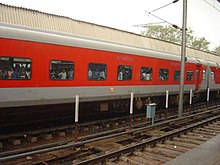
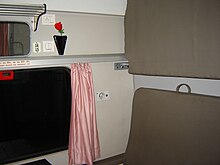


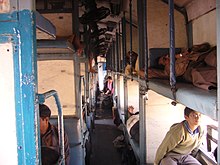
At the rear of the train is a special compartment known as the guard's cabin. It is fitted with a transceiver and is where the guard usually gives the all clear signal before the train departs.
Notable trains and achievements



There are two UNESCO World Heritage Sites on IR – the Chatrapati Shivaji Terminus[28] and the Mountain Railways of India. The latter consists of three separate railway lines located in different parts of India:[29]
- Darjeeling Himalayan Railway, a narrow gauge railway in West Bengal.
- Nilgiri Mountain Railway, a metre gauge railway in the Nilgiri Hills in Tamil Nadu.
- Kalka-Shimla Railway, a narrow gauge railway in the Shivalik mountains in Himachal Pradesh. In 2003 the railway was featured in the Guinness Book of World Records for offering the steepest rise in altitude in the space of 96 kilometre.[30]
- Maharaja Railways (Gwalior Light Railway), a narrow gauge line of just 610mm width from Gwalior to Sheopur of 198 km. in length is world's longest narrow gauge railway line is in the UNESCO world heritage tentative list.
- Neral-Matheran Railway, a narrow gauge railway connecting Matheran is also a historic line.
- Palace on Wheels is a specially designed train, frequently hauled by a steam locomotive, for promoting tourism in Rajasthan. On the same lines, the Maharashtra government introduced the Deccan Odyssey covering various tourist destinations in Maharashtra and Goa, and was followed by the Government of Karnataka which introduced the Golden Chariot train connecting popular tourist destinations in Karnataka and Goa. However, neither of them has been able to enjoy the popular success of the Palace on Wheels.
- Samjhauta Express is a train that runs between India and Pakistan. However, hostilities between the two nations in 2001 saw the line being closed. It was reopened when the hostilities subsided in 2004. Another train connecting Khokhrapar (Pakistan) and Munabao (India) is the Thar Express that restarted operations on 18 February 2006; it was earlier closed down after the 1965 Indo-Pak war.
- Lifeline Express is a special train popularly known as the "Hospital-on-Wheels" which provides healthcare to the rural areas. This train has a carriage that serves as an operating room, a second one which serves as a storeroom and an additional two that serve as a patient ward. The train travels around the country, staying at a location for about two months before moving elsewhere.
- Among the famous locomotives, the Fairy Queen is the oldest operating locomotive in the world today, though it is operated only for specials between Delhi and Alwar. John Bull, a locomotive older than Fairy Queen, operated in 1981 commemorating its 150th anniversary. Kharagpur railway station also has the distinction of being the world's longest railway platform at 1,072 m (3,517 ft). The Ghum station along the Darjeeling Toy Train route is the second highest railway station in the world to be reached by a steam locomotive.[31] The Mumbai–Pune Deccan Queen has the oldest running dining car in IR.
- Vivek Express, between Dibrugarh and Kanyakumari, has the longest run in terms of distance and time on Indian Railways network. It covers 4,286 km (2,663 mi) in about 82 hours and 30 minutes.
- Himsagar Express, between Kanyakumari and Jammu Tawi, has the second longest run in terms of distance and time on Indian Railways network. It covers 3,715 km (2,308 mi) in about 69 hours and 30 minutes. The Bhopal Shatabdi Express is the fastest train in India today having a maximum speed of 150 km/h (93 mph) on the Faridabad–Agra section. The fastest speed attained by any train is 184 km/h (114 mph) in 2000 during test runs.
- The third longest train in terms of distance on Indian Railways network is navyug express between jammu tawi to mangalore covering a distance of 3609 k.m
- Trivandrum Rajdhani is the longest non stop train in on Indian Railways network covering 528 km
Double-decker AC trains have been introduced in India. The first double decker train was Flying Rani introduced in 2005 while the first double-decker AC train in the Indian Railways was introduced in November 2010, running between the Dhanbad and Howrah stations having 10 coaches and 2 power cars.[32]
Problems and issues
A large number of bridges have exceeded their life and need to be replaced. Speed restrictions have to placed on such bridges and this reduces the average speed. Maintenance of tracks is generally manually done and needs to be mechanised.
Indian Railways has outdated communication, safety and signaling equipment on many of its tracks. The speed of updating these with the latest technology is very slow. Manual signally system on the tracks increases the distances between trains and reduces their speeds besides being the cause of a number of train accidents. Interlocking system is available on only a few routes.
The personnel costs and operating costs have increased several times over the past decade but the passenger fares have not been increased. The passenger services are being run at a loss. Freight rates are increased to cross-subsidise the loss in passenger traffic. This drives away the freight traffic to road. Maintenance of passenger coaches and goods wagons is poor and results in derailment and other accidents. Sanitation in trains and stations is poor.
Lack of profit in operations does not allow capital expenditure on better technology in any field. New railway line projects are announced without securing funding for them. The paucity of funds causes time and cost overrun. A large number of these projects are not profitable. A large number of them do not get completed within the scheduled time. As on 31 March 2011, 347 projects including new lines, doubling and gauge conversion were pending and their project cost had escalated to Rs.1,472 billion.[33] However, the railway budget for 2012-13 provided only Rs.130 billion for the projects.
See also
- Bilaspur-Mandi-Leh Railway
- List of countries by rail transport network size
- List of railway stations in India
- Rail transport in India
Notes
- ^ "Times Of India". The Times Of India. India. 15 April 2010.
- ^ "Railway Unit". Official webpage of Indian Railways. Retrieved 6 June 2009.
- ^ a b "Railways Fiscal Budget 2012" (PDF). Retrieved 15 March 2012.
- ^ a b Indian Railways Year Book (2009–2010) (PDF). Ministry of Railways, Government of India. 2011. p. 13. Retrieved 26 August 2008.
- ^ http://im1.indiarailinfo.com/506503/0/remapa309072012.jpg
- ^ R.P. Saxena, Indian Railway History Timeline
- ^ British investment in Indian railway reaches £100m by 1875
- ^ History of Indian Railways
- ^ Sandes, Lt Col E.W.C. (1935). The Military Engineer in India, Vol II. Chatham: The Institution of Royal Engineers.
{{cite book}}:|access-date=requires|url=(help) - ^ http://www.indianrail.gov.in/ir_zones.pdf
- ^ Singh, Vijay Pratap (27 February 2010). "SMS complaint system: A Northern Railway brainwave spreads". Indian Express. Retrieved 19 January 2012.
- ^ "Zones and their Divisions in Indian Railways" (PDF). Indian Railways. Retrieved 26 August 2011 format=PDF.
{{cite web}}: Check date values in:|accessdate=(help); Missing pipe in:|accessdate=(help) - ^ "Railway Board Directorates". INDIAN RAILWAY ESTABLISHMENT CODE. Indian Railways.
- ^ "Indian Railways level which constitutes the Governing Council of Association". irts.org.in.
- ^ "Indian Railways Establishment Manual". rrcb.gov.in.
- ^ "administrative control of the railways". indianrailways.
- ^ "set up as a registered society to design and implement various railway computerization projects". CENTRE FOR RAILWAY INFORMATION SYSTEMS.
- ^ compiled and edited by Research, Reference and Training Division. (2011). India Yearbook 2011. Publications Division, Ministry of Information & Broadcasting, Govt. of India. ISBN 978-81-230-1674-0.
{{cite book}}:|author=has generic name (help); Unknown parameter|unused_data=ignored (help) - ^ http://im1.indiarailinfo.com/506503/0/remapa309072012.jpg
- ^ "Toy Trains Of India". Our Trips – Royal Train Tours. India Calling Tours (P) Limited. Retrieved 12 May 2007.
- ^ India approves new railway link with Bangladesh | TwoCircles.net
- ^ "Railway eyes rail link to China". The Times Of India. India. 10 March 2011.
- ^ "Rail link from Manipur to Vietnam on cards: Tharoor". The Times Of India. India. 9 April 2010.
- ^ Neighbours to the west get closer | Bangkok Post: news
- ^ "railway operations — I". IRFCA.org. Indian Railways Fan Club. Retrieved 11 June 2007.
- ^ a b "General Information on travelling by IR". IRFCA.org. Indian Railways Fan Club. Retrieved 3 June 2007.
- ^ "Class of Travel". indiarail.co.uk. S.D.Enterprises Ltd. Retrieved 3 June 2007.
- ^ "Chhatrapati Shivaji Terminus (formerly Victoria Terminus)". World Heritage List. World Heritage Committee. 2004. Retrieved 5 January 2009.
- ^ "Mountain Railways of India". World Heritage List. World Heritage Committee. 1999. Retrieved 5 January 2009.
- ^ "100 years of pine-scented travel". Retrieved 14 February 2009.
{{cite web}}:|first=missing|last=(help) - ^ "Hill trains". Archived from the original on 22 August 2008. Retrieved 14 February 2009.
- ^ "The curious case of Vijay Mallya - Yahoo! News". In.news.yahoo.com. 20 April 2011. Retrieved 20 February 2012.
- ^ http://articles.economictimes.indiatimes.com/2012-07-27/news/32889414_1_tardy-progress-cost-escalation-railways
References
Scholarly studies
- Aguiar, Marian. Tracking Modernity: India's Railway and the Culture of Mobility (2011)
- Bear, Laura. Lines of the Nation: Indian Railway Workers, Bureaucracy, and the Intimate Historical Self (Columbia University Press, 2007); 360 pp. ISBN 978-0-231-14002-7.
- Tiwari, Ramswarup D. Railways In Modern India (1941) excerpt and text search
- V.M. Govind Krishnan NMR (Nilgiri Mountain Railway)- From Lifeline to Oblivion
Popular sources
- "Indian Railways FAQ". Indian Railways Fan Club. Retrieved 18 June 2006.
- "IR History: Early Days". Indian Railways Fan Club. Retrieved 19 June 2005.
- "Railway Zones". Indian Railways Fan Club. Retrieved 19 June 2005.
- "Railways Reservation". [Railwayreservation.org]. Retrieved 16 June 2010.
- "Famous Trains". Indian Railways Fan Club. Retrieved 19 June 2005.
- "Freight Trains". Indian Railways Fan Club. Retrieved 19 June 2005.
- "Miscellaneous material on Indian Railways". Indian Railways Fan Club. Retrieved 18 June 2006.
- "Trivia". Indian Railways Fan Club. Retrieved 19 June 2005.
- "Salient Features of Indian Railways". Indian Railways. Archived from the original on 18 June 2005. Retrieved 19 June 2005.
- "Indian Railway takes the E-route". Times of India. India. 19 June 2005. Retrieved 19 June 2005.
- "The Rediff Interview". Rediff.com. Retrieved 19 June 2005.
- "A poor track record". Frontline magazine online. Retrieved 19 June 2005.
- Various authors (2004). Guinness Book of World Records-2005. Guinness World Records Ltd. ISBN 0-85112-192-6.
- "Railway Budget 2010–2011". India Rail Info. Retrieved 25 February 2010.
- "5 digit Train Numbering". The Times Of India. India. 19 December 2010.
- "Rail Budget (2012-13) - highlights". TOI. 14-Mar-12.
{{cite news}}: Check date values in:|date=(help) - "Rail budget: How much your ticket will cost now". Rediff.com. Retrieved 15-Mar-12.
{{cite web}}: Check date values in:|accessdate=(help)
External links
- PNR status Indian Railways PNR Status quick check
Template:Link FA Template:Link FA
- IRCTC PNR status Irctc PNR Status
